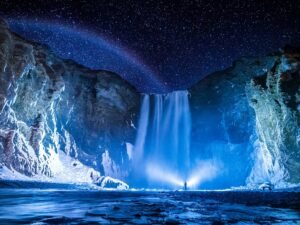When you think about deserts, what comes to mind? Perhaps endless stretches of sun-scorched sand, arid air, and a landscape that seems devoid of life. However, that assumption couldn’t be further from the truth. Beneath the seemingly barren surface of these dry lands lies a tapestry of intricate, thriving ecosystems. These ecosystems are home to a surprising array of plants, animals, and microorganisms, each uniquely adapted to survive some of the harshest conditions on Earth.
This blog will take you on a fascinating journey into the hidden ecosystems of desert landscapes, revealing the brilliance and resilience of life in this underestimated environment.
A Symphony of Survival
Deserts cover approximately 33% of the Earth’s land surface. The two most distinct features of deserts are their aridity—often receiving less than 10 inches of rain annually—and their fluctuating temperatures, which can shift dramatically between day and night. Despite these extreme conditions, deserts buzz with biodiversity if you look closely.
Life in deserts revolves around adaptation. The extreme climate has shaped flora and fauna into innovators of survival, employing clever mechanisms to endure limited water supply, nutrient-poor soils, and unrelenting sun exposure. Intriguing layers of life can be discovered, from the sand itself to the skies above.
The Hidden Architects of the Soil
One of the least visible yet ecologically crucial components of desert ecosystems is biological soil crusts, also known as biocrusts. This fragile crust mixture, comprising lichens, mosses, cyanobacteria, fungi, and other microorganisms, forms on the top layer of soils. Biocrusts act as nature’s engineers—they stabilize shifting sand, increase soil fertility by fixing nitrogen, and retain moisture.
Without biocrusts, desert landscapes would face higher rates of soil erosion, making plant growth even more difficult. These crusts are a hidden lifeline that enables other organisms to thrive above and below the sand.
The Hidden Life Beneath the Sands
Underneath the surface, an entire world exists. Many desert animals are fossorial, meaning they live underground to escape extreme heat and predators. Take, for instance, the Saharan silver ant. This species takes survival to the next level by relying on the reflective properties of its metallic body to deflect intense sunlight, while burrows protect them during outside temperature extremes.
Desert reptiles, such as the shovel-snouted lizard, are expert sand swimmers. They “dive” headfirst into the fine particles to avoid danger or find a more temperate resting spot. Far beneath the surface, some species even form mutualistic relationships with underground fungi, adding a layer of complexity to these underground networks.
Flora and Fauna That Redefine Resilience
The plants and animals of desert landscapes showcase some of the most remarkable adaptations seen in nature. Each species has evolved an arsenal of strategies to make the most of minimal resources.
Flora: Specialists of the Arid World
Desert plants are master conservers of water. Iconic species like cacti store massive amounts of water in their stems, while waxy coatings reduce evaporation. Roots are also architectural marvels; some cacti and shrubs have deep taproots that stretch dozens of feet underground to extract hidden moisture reserves, while others develop widespread shallow roots to capture rainfall quickly.
Take the Welwitschia mirabilis of Namibia’s Namib Desert, for example. This bizarre-looking plant can live over 1,000 years and survives by harvesting moisture from morning fog, thanks to its long, ribbon-like leaves.
Another staple of desert ecosystems is the creosote bush, often regarded as one of the world’s oldest living plants. By releasing chemicals into the soil to prevent competition, it ensures its survival in crowded desert environments.
Fauna: Mirage-Like Masters of Survival
Desert animals are impeccably adapted to the harshness of their surroundings. From insects to birds, mammals, and reptiles, every creature plays a critical role in maintaining ecological balance.
- Fennec Fox: Native to the Sahara Desert, the fennec fox uses its oversized ears to dissipate heat and detect even the smallest vibrations of prey moving beneath the sand.
- Sidewinder Rattlesnake: This snake minimizes contact with hot sand by moving in an S-shaped rolling motion. Its specialized physiological systems also retain moisture and tolerate minimal water consumption.
- Kangaroo Rat: Found in North American deserts, the kangaroo rat survives almost entirely without drinking water. Instead, it obtains hydration metabolically from seeds within its diet.
Each of these desert inhabitants demonstrates how evolutionary ingenuity aids survival in a place where living conditions seem impossible.
The Role of Water in Shaping Desert Life
Contrary to their label as barren wastelands, deserts are often profoundly shaped by water—albeit in scarce and unpredictable forms. Seasonal rains can trigger explosions of life, with flowering plants blooming overnight and animals emerging to feast on newfound resources.
Ephemeral rivers and desert oases provide vital lifelines. During monsoon seasons, wadis (seasonal streams in arid regions) flush dormant seeds into germination, transforming sections of deserts into lush green refuges for grazers and pollinators.
One lesser-known aspect of deserts is their hidden reservoirs of subterranean water, which sustain native communities and ecosystems alike. Fossil water, a relic from ancient wetter periods, remains trapped in deep aquifers beneath action-packed desert soils.
The Keystone Species of Deserts
Keystone species are organisms that have disproportionate effects on their ecosystems relative to their population size. Desert ecosystems rely heavily on specific plants or animals to maintain stability, and without them, the ecological balance could collapse.
- Saguaro Cactus (Sonoran Desert): This majestic plant provides nesting sites for birds, shade for small mammals, and nectar for pollinating bats. Many desert species depend directly on saguaros to survive.
- Termites (Australian Deserts): These small insects play a surprising role as ecosystem engineers. Their nests modify soil structure, improving water infiltration, while they recycle dead plant material, enriching organic matter in the desert soils.
Threats to Desert Ecosystems
While desert ecosystems showcase resilience, they are far from invincible. Climate change, overgrazing, mining, and urbanization pose significant threats. Biocrust degradation, for example, is accelerating due to increased human activities such as off-road vehicle use, which leaves these fragile crusts vulnerable to erosion.
Additionally, invasive species can wreak havoc on native plant and animal populations. For example, the introduction of non-native grasses in some regions of the American Southwest has increased the frequency and intensity of wildfires, causing disruption to native flora like cacti.
Why Protect Desert Ecosystems?
Understanding and conserving desert ecosystems is critical, not just for the survival of the flora and fauna that inhabit them but for humans as well. Deserts are carbon sinks, regulate regional climate patterns, and harbor processes like water purification. They also provide medicinal plants and minerals vital to economies worldwide.
By celebrating the hidden richness of these astounding ecosystems, we can advocate for their protection and steward them for future generations.
Final Thoughts
The hidden ecosystems of deserts reveal that life finds a way, even under the harshest conditions. These landscapes defy the notion of barrenness, showcasing brilliant adaptations, symbiotic relationships, and a fine balance of natural processes. The next time you picture a desert, picture not just sand but an intricate, life-supporting mosaic brimming with mystery and resilience.
Perhaps the desert’s greatest gift is its lesson—we, too, can survive and thrive against all odds. It’s a powerful reminder that beauty and complexity often lie beneath the surface.





